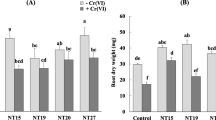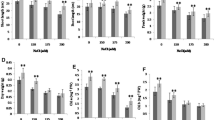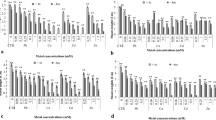Abstract
Heavy metal contamination of agricultural soils has increased along with industrialization. Mercury is a toxic heavy metal and a widespread pollutant in the ecosystem. Mercury-tolerant and plant growth-promoting rhizobacteria (PGPR) HG 1, HG 2, and HG 3 were isolated from the rhizosphere of plants growing in a mercury-contaminated site. These isolates were able to grow in the presence of mercury ranging from 10 to 200 µM in minimal medium and 25 to 500 µM in LB medium. The strains were characterized by morphological, biochemical, and plant growth-promoting traits. In the present study, these PGPR strains were analyzed for their involvement in metal stress tolerance in Triticum aestivum (wheat). Two bacterial strains, namely, Enterobacter ludwigii (HG 2) and Klebsiella pneumoniae (HG 3), showed better growth promotion of T. aestivum seedlings under metal stress. Different growth parameters like, water content and biochemical properties were analyzed in the PGPR-inoculated wheat plants under 75 µM HgCl2. Shoot length, root length, shoot dry weight, root dry weight and relative water content (RWC) were significantly higher in inoculated plants compared to uninoculated plants under stress condition. Proline content, electrolyte leakage, and malondialdehyde content (shoots and roots) were significantly lower in inoculated plants with respect to uninoculated plants under mercury stress. Therefore, it could be assumed that all these parameters collectively improve plant growth under mercury stress conditions in the presence of PGPR. Hence, these PGPRs can serve as promising candidates for increasing plant growth and also have immense potential for bioremediation of mercury-contaminated soils.



Similar content being viewed by others
References
Abou-Shanab RAI, van Berkum P, Angle JS (2007) Heavy metal resistance and genotypic analysis of metal resistance genes in gram-positive and gram-negative bacteria present in Ni-rich serpentine soil and in the rhizosphere of Alyssum murale. Chemosphere 68:360–367
Arnon DI (1949) Copper enzymes in isolated chloroplasts. Polyphenol oxidase in Beta vulgaris. Plant Physiol 24:1–15
Arunakumara KKIU, Walpola BC, Song JS, Shin MJ, Lee CJ, Yoon MH (2014) Phytoextraction of heavy metals induced by bioaugmentation of a phosphate solubilizing bacterium. Korean J Environ Agric 33:155–164
Bajji M, Kinet JM, Lutts S (2002) The use of the electrolyte leakage method for assessing cell membrane stability as a water stress tolerance test in durum wheat. Plant Growth Regul 36:61–70
Bakker AW, Schippers B (1987) Microbial cyanides production in the rhizosphere in relation to potato yield reduction and Pseudomonas spp. mediated plant growth stimulation. Soil Microbiol Biochem 19:451–457
Barkay T, Miller SM, Summers AO (2003) Bacterial mercury resistance from atoms to ecosystems. FEMS Microbiol Rev 27:355–384
Bradford M (1976) A rapid and sensitive method for the quantitation of microgram quantities of protein utilizing the principle of protein-dye binding. Anal Biochem 72:248–258
Bridges CC, Zalups RK (2004) Homocysteine, system b0 and the renal epithelial transport and toxicity of inorganic mercury. Am J Pathol 165:1385–1394
Dash HR, Das S (2012) Bioremediation of mercury and the importance of bacterial mer genes. Int Biodeterior Biodegrad 75:207–213
De J, Ramaiah N, Vardanyan L (2008) Detoxification of toxic heavy metals by marine bacteria highly resistant to mercury. Mar Biotechnol 10:471–477
François F, Lombard C, Guigner J-M, Soreau P, Brian-Jaisson F, Martino G, Vandervennet M, Garcia D, Molinier A-L, Pignol D, Peduzzi J, Zirah S, Rebuffat S (2012) Isolation and characterization of environmental bacteria capable of extracellular biosorption of mercury. Appl Environ Microbiol 78:1097–1106
Gill SS, Tuteja N (2010) Reactive oxygen species and antioxidant machinery in abiotic stress tolerance in crop plants. Plant Physiol Biochem 48:909–930
Gontia-Mishra I, Sharma A (2012) Exogenously supplied osmoprotectants confer enhanced salinity tolerance in rhizobacteria. J Ecobiotechnol 4:11–13
Gontia-Mishra I, Sasidharan S, Tiwari S (2014) Recent developments in use of 1-aminocyclopropane-1-carboxylate (ACC) deaminase for conferring tolerance to biotic and abiotic stress. Biotechnol Lett 36:889–898
Grobelak A, Napora A, Kacprzak M (2015) Using plant growth-promoting rhizobacteria (PGPR) to improve plant growth. Ecol Eng 84:22–28
Hall TA (1999) BioEdit: a user-friendly biological sequence alignment editor and analysis program for Windows 95/98/NT. Nucl Acids Symp Ser 41:95–98
Han HS, Supanjani Lee KD (2006) Effect of co-inoculation with phosphate and potassium solubilizing bacteria on mineral uptake and growth of pepper and cucumber. Plant Soil Environ 52:130–136
Hodges DM, DeLong JM, Forney CF, Prange RK (1999) Improving the thio barbituric acid-reactive-substances assay for estimating lipid peroxidation in plant tissues containing anthocyanin and other interfering compounds. Planta 207:604–611
Israr M, Sahi S, Datta R, Sarkar D (2006) Bioaccumulation and physiological effects of mercury in Sesbania drummonii. Chemosphere 65:591–598
Jha B, Gontia I, Hartmann A (2012) The roots of the halophyte Salicornia brachiata are a source of new halotolerant diazotrophic bacteria with plant growth promoting potential. Plant Soil 356:265–277
Jiang CY, Sheng XF, Qian M, Wang QY (2008) Isolation and characterization of a heavy metal-resistant Burkholderia sp. from heavy metal-contaminated paddy field soil and its potential in promoting plant growth and heavy metal accumulation in metal-polluted soil. Chemosphere 72:157–164
Kameli A, Losel DM (1996) Growth and sugar accumulation in durum wheat plants under water stress. New Phytol 132:57–62
Kupper H, Kupper F, Spiller M (1998) In situ detection of heavy metal substituted chlorophylls in water plants. Photosynth Res 58:123–133
Liu D, Wang X, Chen Z, Xu H, Wang Y (2010) Influence of mercury on chlorophyll content in winter wheat and mercury bioaccumulation. Plant Soil Environ 56:139–143
Lutts S, Kinet JM, Bouharmont J (1996) NaCl-induced senescence in leaves of rice (Oryza sativa L.) cultivars differing in salinity resistance. Ann Bot 78:389–398
Manikandan R, Sahi SV, Venkatachalam P (2015) Impact assessment of mercury accumulation and biochemical and molecular response of Mentha arvensis: a potential hyperaccumulator plant. Sci World J 2015:1–10
Moreno FN, Anderson CWN, Stewart RB, Robinson BH (2008) Phytofiltration of mercury-contaminated water: volatilisation and plant-accumulation aspects. Environ Exp Bot 62:78–85
Murashige T, Skoog F (1962) A revised medium for rapid growth and bioassay with tobacco tissue cultures. Physiol Plant 15:473–497
Patra M, Sharma A (2000) Mercury toxicity in plants. Bot Rev 66:379–422
Patra M, Bhowmik N, Bandopadhyay B, Sharma A (2004) Comparison of mercury, lead and arsenic with respect to genotoxic effects on plant systems and the development of genetic tolerance. Environ Exp Bot 52:199–223
Patten CL, Glick BR (2002) Role of Pseudomonas putida indole acetic acid in the development of the host plant root system. Appl Environ Microb 68:3795–3801
Prasad MNV (2003) Biomarkers. In: Prasad MNV, Hagemeyer J (eds) Heavy metal stress in plants from molecules to ecosystem. Springer, Berlin, pp 445–448
Qayyum A, Razzaq A, Ahmad M, Jenks MA (2011) Water stress causes differential effects on germination indices, total soluble sugar and proline content in wheat (Triticum aestivum L.) genotypes. Afr J Biotechnol 10:14038–14045
Quiñones MA, Ruiz-Díez B, Fajardo S, López-Berdonces MA, Higueras PL, Fernández-Pascual M (2013) Lupinus albus plants acquire mercury tolerance when inoculated with an Hg-resistant Bradyrhizobium strain. Plant Physiol Biochem 73:168–175
Qurashi AW, Sabri AN (2012) Bacterial exopolysaccharide and biofilm formation stimulate chickpea growth and soil aggregation under salt stress. Braz J Microbiol 43:1183–1191
Ruiz-Diez B, Quinones MA, Fajardo S, Lopez MA, Higueras P, Fernandez-Pascual M (2012) Mercury-resistant rhizobial bacteria isolated from nodules of leguminous plants growing in high Hg-contaminated soils. Appl Microbiol Biotechnol 96:543–554
Sahu GK, Upadhyay S, Sahoo BB (2012) Mercury induced phytotoxicity and oxidative stress in wheat (Triticum aestivum L.) plants. Physiol Mol Biol Plants 18:21–31
Saitou N, Nei M (1987) The neighbor-joining method: a new method for reconstructing phylogenetic trees. Mol Biol Evol 4:406–425
Sambrook J, Fritsch EF, Maniatis T (1989) Molecular cloning: a laboratory manual. Cold Spring Harbor Laboratory, New York
Sarathambal C, Ilamurugu K, Balachandar D, Chinnadurai C, Gharde Y (2015) Characterization and crop production efficiency of diazotrophic isolates from the rhizosphere of semi-arid tropical grasses of India. Appl Soil Ecol 87:1–10
Saravanan VS, Subramoniam SR, Raj SA (2003) Assessing in vitro solubilization potential of different zinc solubilizing bacterial (ZSB) isolates. Braz J Microbiol 34:121–125
Sas-Nowosielska A, Galimska-Stypa R, Kucharski R, Zielonka U, Małkowski E, Gray L (2008) Remediation aspect of microbial changes of plant rhizosphere in mercury contaminated soil. Environ Monit Assess 137:101–109
Sharma A, Gontia I, Agarwal PK, Jha B (2010) Accumulation of heavy metals and its biochemical responses in Salicornia brachiata, an extreme halophyte. Mar Biol Res 6:511–518
Shukla PS, Agarwal PK, Jha B (2012) Improved salinity tolerance of Arachis hypogaea (L.) by the interaction of halotolerant plant-growth-promoting rhizobacteria. J Plant Growth Regul 31:195–206
Sobrino-Plata J, Ortega-Villasante C, Flores-Cáceres ML, Escobar C, del Campo FF, Hernández LE (2009) Differential alterations of antioxidant defenses as bioindicators of mercury and cadmium toxicity in Alfalfa. Chemosphere 77:946–954
Srivastava S, Singh N (2014) Mitigation approach of arsenic toxicity in chickpea grown in arsenic amended soil with arsenic tolerant plant growth promoting Acinetobacter sp. Ecol Eng 70:146–153
Sun LN, Zhang YF, He LY, Chen ZJ, Wang QY, Qian M, Sheng XF (2010) Genetic diversity and characterization of heavy metal-resistant-endophytic bacteria from two copper-tolerant plant species on copper mine wasteland. Biores Technol 101:501–509
Tamura K, Nei M, Kumar S (2004) Prospects for inferring very large phylogenies by using the neighbor-joining method. Proc Natl Acad Sci 101:11030–11035
Weisburg WG, Barns SM, Pelletier DA, Lane DJ (1991) 16S ribosomal DNA amplification for phylogenetic study. J Bacteriol 173:697–703
Zhang HX, Blumwald E (2001) Transgenic salt-tolerant tomato plants accumulate salt in foliage but not in fruit. Nat Biotechnol 19:765–768
Zhang YF, He LY, Chen ZJ, Wang QY, Qian M, Sheng XF (2011) Characterization of ACC deaminase-producing endophytic bacteria isolated from copper-tolerant plants and their potential in promoting the growth and copper accumulation of Brassica napus. Chemosphere 83:57–62
Zhou ZS, Guo K, Elbaz AA, Yang ZM (2009) Salicylic acid alleviates mercury toxicity by preventing oxidative stress in roots of Medicago sativa. Environ Exp Bot 65:27–34
Acknowledgments
The author I. G. M. thankfully acknowledges financial support received from the Science and Engineering Research Board (Grant # SB/FT/LS-374/2012), Department of Science and Technology, New Delhi, India.
Author information
Authors and Affiliations
Corresponding author
Rights and permissions
About this article
Cite this article
Gontia-Mishra, I., Sapre, S., Sharma, A. et al. Alleviation of Mercury Toxicity in Wheat by the Interaction of Mercury-Tolerant Plant Growth-Promoting Rhizobacteria. J Plant Growth Regul 35, 1000–1012 (2016). https://doi.org/10.1007/s00344-016-9598-x
Received:
Accepted:
Published:
Issue Date:
DOI: https://doi.org/10.1007/s00344-016-9598-x




